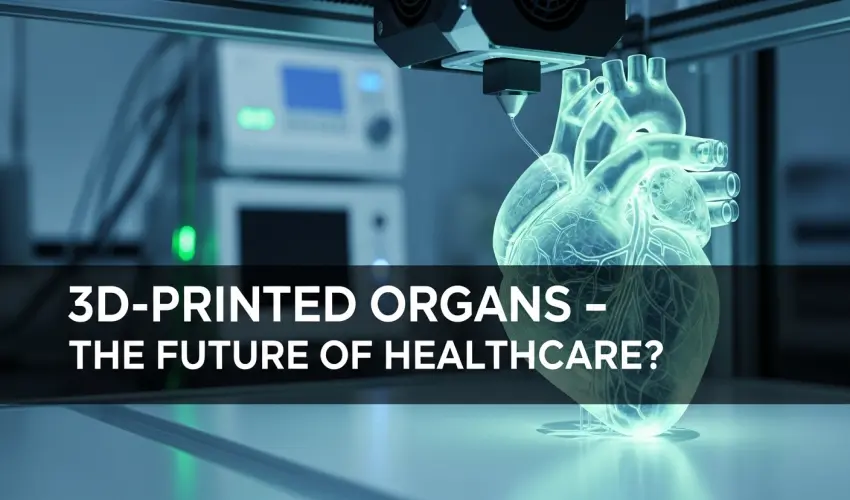3D-Printed Organs – The Future of Healthcare?
Published Jan 20, 2025
1 0
Key Takeaways
-
3D bioprinting uses living cells as "bio-ink" to create tissues and, potentially, full organs.
-
It offers solutions to organ shortages, reduces rejection risk, and allows for customized healthcare.
-
Current successes include 3D-printed mini-livers, blood vessels, skin, and cartilage.
-
Major challenges include vascularization, replicating organ complexity, high costs, and regulatory approval.
-
Experts believe 3D-printed tissues and simpler organs will become mainstream within 10 to 20 years.
Introduction
Picture a future where you don't have to wait months, or even years, for a life-saving organ transplant. A future of organs made to order, specially tailored to your body and ready just when you need them. This future may not be so distant, thanks to the revolutionary technology of 3D bioprinting.
3D-printed organs could transform transplant medicine by eliminating the need for donations and even help combat diseases like cancer with fewer side effects. So how close are we to making this a reality? Let’s go beyond the hype and explore how 3D bioprinting is moving from science fiction to science fact.
What is 3D Bioprinting?
Fundamentally, 3D bioprinting works on the same core principles as standard 3D printing, only it layers living cells rather than plastic or metal. Specialized printers release “bio-ink”—a mixture of living cells and supportive gel-like materials—to form structures that mimic real human tissues.
Using a digital blueprint of an organ, scientists instruct the printer on where to place each specific cell type. The structures are built layer-by-layer, enabling the creation of complex designs that replicate the fundamentals of hearts, kidneys, and lungs. The ultimate goal isn’t just to make organ-like shapes, but to create fully functional, transplantable organs that can be integrated into the human body.
How Are 3D-Printed Organs Created?
The process of creating a 3D-printed organ is intricate and precise, typically following several key steps:
-
Cell Collection: Scientists start by collecting cells from the patient or a donor. Using the patient’s own cells is ideal as it dramatically reduces the risk of the body rejecting the new organ.
-
Bio-Ink Preparation: The collected cells are mixed with a nutrient-rich gel to create the bio-ink. This gel provides a supportive environment for the cells to grow and thrive.
-
Design and Modeling: A detailed digital model of the organ is created using imaging technologies like MRI or CT scans. This serves as the blueprint for the printer.
-
Printing: The 3D bioprinter meticulously lays down layers of bio-ink according to the digital model, forming the basic structure of the organ.
-
Maturation: The printed organ is placed in a bioreactor—a device that provides a controlled environment—where it matures and develops the necessary functionality to survive.
This complex process requires incredible precision. Every tiny blood vessel and tissue type must be perfectly placed to ensure the organ works properly.
Why 3D-Printed Organs Are a Game-Changer
The potential benefits of 3D-printed organs are enormous and could revolutionize medicine as we know it.
-
Solving Organ Shortages: Thousands of patients die every year waiting for organ transplants. 3D printing could eliminate this shortage by creating organs on demand, saving countless lives.
-
Reducing Transplant Rejection: By using a patient’s own cells, scientists can print organs that are a perfect genetic match. This could drastically reduce or even eliminate the risk of organ rejection and the need for lifelong immunosuppressant drugs.
-
Faster Availability: Traditional organ transplants involve long waiting lists and complex logistics. 3D printing could provide faster, more reliable access to life-saving treatments.
-
Complete Customization: Printed organs can be tailored exactly to a patient’s anatomy, taking into account their size, shape, and specific health conditions.
-
Advancing Medical Research: Beyond transplants, 3D-printed tissues provide powerful tools for research. Scientists can test new drugs, study diseases, and better understand human biology without needing human or animal subjects.
Current Achievements in 3D Bioprinting
While we are not yet printing fully functioning human hearts or kidneys ready for transplant, the progress is impressive:
-
Researchers have successfully printed mini-livers and kept them alive for short periods.
-
Scientists have created heart tissue capable of beating just like real cardiac tissue.
-
3D-printed skin, cartilage, and blood vessels are already being used in research and some clinical settings.
Companies like Organovo and research centers like the Wake Forest Institute for Regenerative Medicine are leading these incredible advances, proving that the concept works. The next step is scaling up to create larger, fully functional organs capable of long-term survival inside the human body.
Challenges in 3D-Printing Organs
Despite its promise, 3D bioprinting faces several serious hurdles before it becomes mainstream.
-
Complexity of Human Organs: A heart is not just muscle; it has intricate valves, blood vessels, and electrical systems. Recreating this complex architecture is a monumental challenge.
-
Vascularization: One of the biggest obstacles is creating a network of blood vessels (vascularization) within the printed organs. Without blood flow to deliver nutrients and remove waste, larger tissues cannot survive.
-
Cell Sourcing: Obtaining the right types of cells in sufficient quantities remains difficult. Some cell types are hard to grow and multiply outside the body.
-
Cost: Current bioprinting technology is extremely expensive, limiting its availability to elite research labs and specialized institutions.
-
Regulatory Approvals: Even if the science is perfected, regulatory agencies like the FDA must approve any 3D-printed organs for human use. This involves rigorous, time-consuming testing to ensure safety and efficacy.
Ethical Considerations
Like any powerful new technology, 3D-printed organs raise important ethical questions:
-
Who will have access to this technology? Will it only be available to the wealthy?
-
How do we ensure that printed organs are used fairly and responsibly?
-
Could this technology lead to a black market for bioprinted body parts?
Careful regulation and clear ethical guidelines will be necessary to prevent misuse and ensure equitable access for all who need it.
The Future Outlook
Most experts believe that within the next 10 to 20 years, 3D-printed tissues and simpler organs like bladders or skin grafts will become common in hospitals. More complex organs like kidneys, hearts, and lungs may take longer but are very much within reach.
In the long run, bioprinting could extend beyond simply replacing organs. Scientists imagine printing hybrid organs that enhance human capabilities or combining synthetic materials with biological cells for super-durable tissues. The ultimate dream? A world where nobody dies from organ failure.
Conclusion
3D-printed organs represent a breathtaking leap forward in medicine. While many hurdles remain, the progress so far is inspiring. With continued research, investment, and ethical oversight, the dream of printing functional, transplantable human organs is moving closer to reality, layer by layer.








